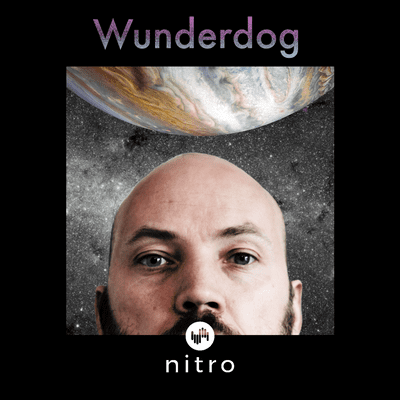
Wunderdog
Podcast by Øystein Runde & Nitro
90 vrk ilmainen kokeilu
Kokeilun jälkeen 7,99 € / kuukausi.Peru milloin tahansa.

Enemmän kuin miljoona kuuntelijaa
Tulet rakastamaan Podimoa, etkä ole ainoa
Arvioitu 4.7 App Storessa
Lisää Wunderdog
If life stays on one planet, then one day that planet will be uninhabitable and that will be the end of all life in the universe. We should get out more. Wunderdog is a collection of talks with people who have ideas about how to do this.
Kaikki jaksot
19 jaksot"Extreme trans-Neptunian Objects" - or chunks of rock that orbit the sun on average 250 times further away from the sun than Earth does - are moving in strange ways. They seem to be clustered somewhat, and Brown / Batygin suggested in 2016 that an explanation could be a hidden ninth planet in our solar system, around 5-10 earth masses. Terry Long Phan, astronomy graduate student at National Tsing Hua University in Taiwan, has led a study to look for this extremely far away planet in a new way: Using the infrared spectrum. Terry compared 1983 data from the Infrared Astronomical Satellite (IRAS) [https://www.jpl.nasa.gov/missions/infrared-astronomical-satellite-iras/] with 2006 data from Japan’s AKARI [https://www.isas.jaxa.jp/en/missions/spacecraft/past/akari.html] mission - and found a single object that has potential. Barring Pluto (found 1930 and disqualified in 2006) the last time anyone found a new planet in our solar system was when Urbain Le Verrier and Johann Gottfried Galle found Neptune in 1846. So if Terry has found a proper planet - this could be a big moment. But is it true? In September Phan and Goto will make a third observation to verify the finding, and until then, this podcast gives you the details on how they looked for planet nine, what they found, and what they will look for in September. You can read more about Terry Phan's paper here, https://www.astronomy.com/science/have-astronomers-found-planet-nine/ [https://www.astronomy.com/science/have-astronomers-found-planet-nine/] or see the original paper here: https://arxiv.org/abs/2504.17288 [https://arxiv.org/abs/2504.17288] Wunderdog is sponsored by my patrons at patreon.com/runde [http://patreon.com/runde], and the music is from Trop1ce aka Charky.
Noland is an affable Arizonian with an advanced piece of tech in his skull: A Neuralink. With it, Noland can see his own brainwaves and control his computer ... somewhat. Often his powers are not very much more than what anyone with a hand could do ... but as he mentioned on Joe Rogan two weeks ago, he has one crazy power: He has an aimbot in his head. How does this work? Why is his precision so high? What will the future bring for Neuralink? As Noland says: "This is as bad as it's ever going to be." And it's pretty good. We get into how Noland became paralyzed and the mystery of how it happened - and Noland's surprising (or not so surprising) attitude to this mystery. We also, over two hours, delve into the technical nuances of how Noland uses his brain-computer interface, and in the end talk a little about Elon Musk, about how Noland's life was before his accident, and about his faith. Don't miss this episode!
NASA JPL intern Maya D. Yanez has recently defended her Ph.D. on acetylenotrophy. This is the ability to extract energy from acetylene, and only a few species of bacteria (that we know of here on Earth) have it. They aren't very studied, and there's never been astrobiology studies specifically about this - so Maya's Ph.D. represents a whole new possibility for life to exist on other worlds. Timestamps: 00:00 Introduction and the Potential for Life on Titan 02:06 Titan's Unique Environment and Habitability 05:37 Understanding Moles and Molecules on Titan 09:25 The Role of Water and Amino Acids on Titan 12:37 The Importance of Tungsten and Other Metals for Microbes on Titan 18:44 Impact Melt Ponds and Potential Habitability on Titan 29:18 The Dragonfly Mission and Selk Crater 32:09 Discovering New Microbes and Metabolisms 36:21 The Role of Acetylene in the Origins of Life 53:00 Formation of Planets from Gas and Dust Clouds 57:40 Formation of the Solar System and the Dichotomy of Gas Giants and Rocky Planets 01:05:27 Moons and the Potential for Life on Titan 01:19:45 Redefining Life to Include Different Forms 01:21:42 Proto-Life and Categorizing Life 01:23:27 The Enigma of Viruses 01:25:15 Evolution of Viruses and Bacteria 01:32:47 Acetylene-Eating Microbes and Life on Titan 01:43:09 Isotopic Fractionation and Tracing Life 01:46:16 Personal Journey and Pursuing a Scientific Career 01:51:54 Pursuing Higher Education and Cultural Identity Loss 01:54:09 The Impact of Mentors and Belief in Success 01:57:19 The First Astrobiology Application of Acetylenotrophs 02:01:12 The Future of Maya's Research and Publications 02:05:30 Exploring Monopoles and Other Physics Concepts 02:07:18 Life Inside Stars and Cosmic Bullet Holes 02:09:05 The Fascination of Science at Different Scales 02:13:13 Science Education and Lesson Plans for Elementary Students 02:18:23 Resources for Further Exploration 02:21:34 The Importance of Diversity and Inclusion in STEM 02:23:42 Challenges Faced by Early Career Scientists 02:29:14 Exploring the Potential for Life on Other Planets 02:42:41 Ethical Considerations in Space Exploration AI summary: Maya Yanez discusses the potential for microbial life on Saturn's moon Titan. While it is unlikely that Earth microbes could survive on Titan, there is a possibility that microbes have evolved or originated on Titan and are accustomed to its unique conditions. Titan's thick atmosphere, comprised of nitrogen and methane, protects the surface from radiation. The presence of hydrocarbons, such as acetylene, in Titan's atmosphere and on its surface is a key factor in its potential habitability. The subsurface ocean on Titan, which is 18 times the volume of Earth's oceans, is another exciting aspect that could support life. Maya discusses the energy choices of microbes and how they impact their metabolism. She explains how energy-yielding reactions have led to the discovery of new microbes and metabolisms on Earth. Maya also talks about the importance of anammox in the nitrogen cycle and the conditions necessary for life to exist on other planets. She discusses the formation of the solar system and the role of supernovae in the condensation of gas and dust to form planets. The conversation explores the formation of the solar system and the conditions necessary for life on other planets. It discusses the differences between gas giants and rocky planets, the process of fusion in stars, and the temperature variations in the sun. The possibility of landing on the sun and the Parker Solar Probe mission are also mentioned. The conversation then delves into the formation of moons and the potential for life on Titan, focusing on the presence of complex organic chemistry, protection from cosmic radiation, and the availability of minerals. The importance of phosphorus in life and the search for extraterrestrial life that is different from life on Earth are also discussed. The conversation in this part focuses on the definition of life and the potential for life on other planets. The concept of life with a Y is introduced, which encompasses all types of life on Earth and the potential for life as we don't know it. The discussion also touches on the origins of viruses and their relationship to bacteria. The energy storage molecule ATP is mentioned, and the density of energy it contains is explored. The conversation concludes with a personal story about Maya's educational journey and her passion for learning. Maya shares her journey of pursuing higher education and her experiences as a minority in the field of science. She discusses the challenges she faced, including cultural identity loss and self-doubt. Maya highlights the importance of having mentors who believe in you and the impact they can have on your success. She also talks about her research on acetylenotrophs and the potential for life on Titan. Maya concludes by sharing her passion for science education and her efforts to make science accessible to young students. In this final part of the conversation, Maya discusses her work at USC and her aspirations to work at JPL. She also talks about the budget cuts at NASA and the importance of diversity and inclusion in STEM. Maya shares how she has inspired her younger family members to pursue science and emphasizes the need for representation in the field. The conversation then delves into the potential for life on Mars, Venus, Europa, and Titan, and the ethical considerations of human exploration and colonization of other planets. Keywords Titan, microbes, potential habitability, hydrocarbons, subsurface ocean, microbes, energy choices, metabolism, energy-yielding reactions, new microbes, anamox, nitrogen cycle, life on other planets, solar system formation, supernovae, gas and dust condensation, solar system formation, gas giants, rocky planets, fusion, temperature of the sun, landing on the sun, Parker Solar Probe, formation of moons, life on Titan, complex organic chemistry, cosmic radiation, minerals, phosphorus, extraterrestrial life, definition of life, life with a Y, potential for life, viruses, bacteria, ATP, energy density, educational journey, higher education, minority representation, cultural identity, self-doubt, mentors, research, acetylenotrophs, life on Titan, science education, USC, JPL, budget cuts, diversity, inclusion, STEM, inspiration, life on Mars, life on Venus, life on Europa, life on Titan, human exploration, colonization, ethics Takeaways Microbes from Earth are unlikely to survive on Titan, but there is a possibility of microbes that have evolved or originated on Titan. Titan's thick atmosphere, comprised of nitrogen and methane, protects the surface from radiation. The presence of hydrocarbons, such as acetylene, in Titan's atmosphere and on its surface is a key factor in its potential habitability. Titan's subsurface ocean, which is 18 times the volume of Earth's oceans, is another exciting aspect that could support life. Microbes make energy choices based on the type of diet and metabolism they perform. Energy-yielding reactions have led to the discovery of new microbes and metabolisms on Earth. Anamox is critical to the nitrogen cycle and was theorized based on its energy-yielding potential. The formation of the solar system involved the condensation of gas and dust, triggered by a nearby supernova explosion. Gas giants like Jupiter and Saturn formed farther away from the sun and were able to capture hydrogen and helium gas, while rocky planets like Earth did not capture these gases and remained closer to the sun. The temperature of the sun varies, with the surface being cooler than the corona, which can reach millions of degrees Kelvin. The Parker Solar Probe mission flew close to the sun, but there is no solid surface to land on. Moons can be formed through capture, formation in place, or other processes, and Jupiter's moons are believed to have formed in place. Titan, one of Jupiter's moons, has conditions that could potentially support life, including complex organic chemistry, protection from cosmic radiation, and the availability of minerals. Phosphorus is an essential element for life, as it is part of the DNA molecule. The search for extraterrestrial life should consider the possibility of life forms that are different from those on Earth. Defining life in a way that is agnostic but encompasses all types of life on Earth is a challenge for astrobiologists. The concept of life with a Y provides a framework for categorizing the results of potential life on other planets. Viruses are not unanimously considered to be alive on Earth, but if found on another planet, they may be considered a form of life. ATP is a molecule that carries energy and is essential for the functioning of cells. Maya's educational journey highlights the importance of encouragement and support in pursuing a career in science. The importance of having mentors who believe in you and support your goals The impact of cultural identity loss on minority students in higher education The challenges and self-doubt experienced by students pursuing science The potential for life on Titan and the research on acetylenotrophs The importance of making science education accessible to young students Maya primarily conducted her work at USC, but she has also been involved with JPL and aspires to work there in the future. NASA has faced budget cuts, which have affected JPL and led Maya to explore other career options in education and outreach. Maya has inspired her younger family members to pursue science and encourages diversity and inclusion in STEM. The potential for life on Mars, Venus, Europa, and Titan is discussed, with considerations of energy availability and ethical concerns. Exploration of space should prioritize scientific discovery and understanding before considering tourism and colonization. Titles The Significance of Titan's Subsurface Ocean The Unique Conditions and Habitability of Titan Microbes and Energy Choices The Importance of Anamox in the Nitrogen Cycle The Possibility of Life on Titan The Importance of Phosphorus in Life ATP: The Energy Currency of Cells The Enigma of Viruses: Alive or Not? Exploring the Potential for Life on Titan Navigating Higher Education as a Minority in Science Budget Cuts at NASA and Career Options Inspiring the Next Generation of Scientists Sound Bites "Could I take some microbes from here on earth and dump them onto Titan's surface and would they survive? That answer is probably no." "Titan is very unique when it comes to solar system bodies. I like to view it as the most Earth-like body in the solar system." "Every hydrocarbon that we find on Titan's surface is likely sourced from methane at the beginning of the day." "Microbes, the choice for them is really about energy." "Energy-yielding reactions have led to the discovery of brand new microbes and brand new metabolisms here on Earth." "Anamox is critical to how nitrogen is cycled around the world." "That's why Uranus and Neptune are our ice giants, is that they were far enough away from the sun that they could coalesce rocks and metals and then get the hydrogen ices or hydrogen compounds and other ices forming." "The rocky planets, those close to the sun, did not get massive enough to begin to capture hydrogen and helium gas. If we did, we would have been closer to gas giants." "I could look into the sky and then I could see the sun turn on." "How do we define life in a way that is agnostic but encompasses all types of life on Earth?" "If we found viruses somewhere else, we would say that we found life, yet we don't consider them to be life on Earth." "Viruses are encapsulated. Viruses do carry genetic material that they can use to produce future cells." "I didn't realize how much of my own Hispanic and Mexican identity I was losing being in a town where I couldn't speak Spanish, I couldn't pick up the grocery store, like things at the grocery store I would normally grab." "I'm struggling in this thing. It must mean that I can't do this thing. And that's not true." "Hi, I failed physics. Will you still work with me?" "I'm also so impressed at how you have time to spend on all these kids doing all this extra stuff on top of working in NASA JPL" "I have five niblings, five nieces and nephews. Three of them are not yet in school. But the two older ones, one of them absolutely loves space, just had a space themed birthday party and loves math." "If you have a more diverse team in regards to race, gender, all kinds of different things, you will have more innovative ideas."
Blockchain is a mystery to me, so I don't usually talk about blockchain projects. But Vinay Gupta is awesome. He thinks about climate refugees ALL THE TIME, and many of his projects, from the current most used housing system for Burning Man participants, the Hexayurt, to his ambitious website http://myhopeforthe.world/ [http://myhopeforthe.world/] are made to give climate refugees more tools. On top of these practical ideas, Vinay is also the founder of Mattereum. Mattereum is a blockchain technology, and it aims to allow enforceable contracts for everyone, from big corporations to individuals. The goal is to give climate refugees the same access to the law as anyone else, and ensure economic transparency when the necessary global economic aid is given. Vinay was part of the team that built Ethereum, which is currently the second biggest cryptocurrency network in the world. He knows something about blockchain and what it CAN be used for, but he's also seen how blockchain has been taken hostage by economic speculation. I think the idea is that by being a practical tool, Mattereum will be used so much for practical purposes that the "speculation" in it will mostly drown in all the real-life use cases. I've had Vinay on before - I enjoy talking to him a lot. My current level of understanding blockchain is that it's a bunch of pieces of math stuck together like a long train, and you can't cheat and change any of the old wagons, so the old wagons will be attached to the train forever. That makes the train very trustworthy, somehow. I'm not sure if every problem needs to be solved with blockchain. That's what this episode will try to convince me of. Also we'll laugh about stuff, since he's a funny scot-indian and I like him. Presented by Nitro Studio and the people who support me on www.patreon.com/runde. [www.patreon.com/runde.] Music by Trop1ce. Keywords Vinay Gupta, Mattereum, climate refugees, aid system, financial transparency, blockchain, enforceable contracts, global system of justice, AI, arbitration tribunals Takeaways * Vinay Gupta is working on rehousing climate refugees by fixing the aid system and implementing financial transparency. * Mattereum aims to create a global system of justice that allows for trade and enforceable contracts at all levels. * The use of blockchain technology ensures the transparency and immutability of records. * AI is being explored in arbitration tribunals to make the justice system more efficient and affordable. Titles * Blockchain and AI in Enforceable Contracts * Ensuring Access to Courts for Climate Refugees Sound Bites * "We lose a third of the money when we do transactions, which is typical in the aid industry." * "Nearly all human disputes, if you throw it to an AI system with all of the data in place, within five or 10 years, the AI system will be able to give a strong indication of which way it will go if it goes all the way to a human litigator." * Øystein: "This, Mattereum, is the first step for you - and the whole life project for you is building refugee cities." Chapters 00:00 Introduction and Background 02:08 The Role of Blockchain in Ensuring Financial Transparency 03:29 Fixing the Aid System and Building Trust 05:21 The Potential of AI in Dispute Resolution 07:41 Creating Trust and Trade with Mattereum 09:08 Addressing the Climate Refugee Crisis
Note my NEW FORMAT: 10 minutes of quick questions first, then a deeper talk about ideas, motivation and process after. "I don't think it really matters if our profound connection happens with a digital or a physical intelligence" says Kevin Fischer, quantum physics pHd turned OpenSouls Ai CEO. And ... as offputting as this statement felt to me in the beginning, our conversation quickly got very spiritual. I can't wrap my head around his quantum physics, and I'm not going into the specifics of what OpenSouls does to create souls (this may have been a mistake), but I wanted to talk to Kevin as a person. His goal is to give AI a "soul". But what is a soul? And how does Kevin's soul work? Ai-generated summary (sorry to all the people in the summary-writing industry losing their income to this, this is Riverside's fault!) Kevin, the founder of OpenAI's Open Souls, discusses his background in quantum physics and the importance of disconnecting from social media to focus on deep thinking. He shares how he started Open Souls and the role of Twitter in building the company. Kevin also talks about the team at Open Souls, which consists of artists, entrepreneurs, and engineers, and their creative approach to AI art. He expresses optimism about the integration of AI technology into artistic workflows and the potential for artists to harness its power. The conversation also touches on the impact of social media on our emotional relationship with technology, the role of Twitter in networking and collaboration, and Elon Musk's approach to chaos. Finally, Kevin reflects on his own social preferences and the challenges of balancing his identity as a physicist with his role as a business leader. In this conversation, Kevin discusses his creative process and the connection between meditation and his work in theoretical physics and AI. He shares his experiences of receiving insights and visions that guide his work. Kevin also explores the intersection of science and spirituality, discussing the role of consciousness and subjective experience in scientific discovery. He explains his motivation for creating AI souls and the potential impact on our culture. The conversation touches on topics such as the nature of creativity, the limits of human understanding, and the possibility of digitizing souls. Keywords quantum physics, social media, deep thinking, Open Souls, Twitter, AI art, creative team, artistic workflows, emotional relationship with technology, networking, collaboration, Elon Musk, chaos, social preferences, physicist, business leader, creativity, meditation, theoretical physics, AI, spirituality, consciousness, subjective experience, AI souls, culture, digitizing souls Takeaways * Disconnecting from social media can enhance deep thinking and focus * Twitter can be a powerful tool for networking and building a company * AI technology can be a superpower for artists when integrated into their creative workflows * Our emotional relationship with technology is complex and influenced by its multifaceted nature * Elon Musk's approach to chaos is a deliberate choice * Balancing personal identity and professional roles can be challenging Meditation and creating from a place of stillness can lead to powerful insights and visions. * The process of doing theoretical physics can be meditative, involving the combination of abstract shapes and feelings. * The act of doing science in the best way can be a spiritual process. * There may be an additional field that gives rise to subjective experience, and meditation and psychedelics can provide glimpses into this connection. * Creating a new species of life through AI has the potential to radically change our culture. * Cloning a soul is not possible, as each clone would have its own unique experiences and evolution. Titles * Elon Musk and the Deliberate Embrace of Chaos * Twitter: A Tool for Networking and Collaboration The Spiritual Nature of Science * The Limitations of Cloning Souls Sound Bites * "What is it you do with a PhD in quantum physics?" * "To do theoretical physics, what matters are your thoughts, the second order thoughts, the third order thoughts, and what your subconscious is doing in the background." * "Twitter is actually a tool that you can use to build a company." * "I really enjoyed the part where you said you needed to clean out your whole mind space to create stuff from scratch." * "How long can you maintain this non-Kevin facade when it brings you closer?" * "The thing about computers is that they're these cold, emotionless objects. And I wanted to make them feel warm." Chapters 00:00 The Power of Deep Thinking and Disconnecting from Social Media 02:55 Building Open Souls: The Role of Twitter and AI Art 03:45 The Creative Team at Open Souls: Artists, Entrepreneurs, and Engineers 08:21 The Optimism of Integrating AI Technology into Artistic Workflows 10:45 The Complex Relationship Between Emotions and Technology 12:17 Twitter: A Tool for Networking and Collaboration 15:09 Elon Musk and the Deliberate Embrace of Chaos 16:26 Navigating Personal Identity and Professional Roles 23:34 The Meditative Process of Theoretical Physics 27:19 The Spiritual Nature of Science 33:25 Exploring the Connection Between Consciousness and Subjective Experience 38:09 Creating a New Species of Life: AI and Culture 40:46 The Limitations of Cloning Souls

Arvioitu 4.7 App Storessa
90 vrk ilmainen kokeilu
Kokeilun jälkeen 7,99 € / kuukausi.Peru milloin tahansa.
Podimon podcastit
Mainoksista vapaa
Maksuttomat podcastit

































